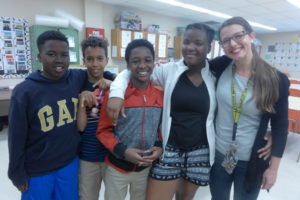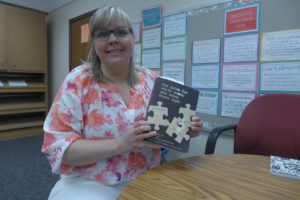White women make up 70% of the teachers in Wisconsin. In Fond du Lac, the percentage is even higher in a city where there are more and more students of color. So, some teachers there are trying to improve the way they work with students who come from backgrounds different from their own.
They’re studying The Guide For White Women Who Teach Black Boys. The book was edited by The Privilege Institute director and Green Bay resident Dr. Eddie Moore Jr., University of Wisconsin-Oshkosh’s Educational Leadership and Policy Department Chair in the College of Education and Human Services Dr. Marguerite Penick-Parks, and Ali Michael.
“When you look at the statistics about whose schools are being successful and whose are failing, we’ve historically not been very successful with African-Americans and predominantly African-American boys,” said Dr. Penick-Parks. “They’re being expelled more. They’re being suspended more. You can look at the reading and math gaps in the test scores. Look at the school-to-prison pipeline. It was a recognition that this population has never been successful within the American public schools.”
The first steps are getting teachers comfortable talking about race with each other and exploring their own identities.
“So, when a student asks you a question you don’t avoid it, but you talk about it,” said Dr. Penick-Parks.
RACE IN ELEMENTARY SCHOOL

Fourth graders Jakyla Smith, Nolen Henigan, and Sam Tynen interview each other after talking with their teacher about race. (Maureen McCollum/WPR)
At Chegwin Elementary School in Fond du Lac, Wisconsin, fourth grade teacher Pam Yanagihashi meets with a few of her students, Jakyla Smith, Sam Tynan, and Nolen Henigan. Yanagihashi is carrying the 472 page book and instantly, a curious Henigan asks her, “Why is it called The Guide for White Women Who Teach Black Boys?”
“What we want to do is teach black boys better,” Yanagihashi tells the students. “Sometimes, the education system is failing black boys and black girls because sometimes they’re being stereotyped into certain groups or not having all the same opportunities as the white boys or white girls. So it’s like, how can we make it best for everybody to learn so that, Nolen, you can be successful.”
The children nod along, smiling. Each of them appear comfortable talking about race, although they’d prefer talking about sports, their love of singing and dancing, and their favorite subjects: math and gym.
Tynan said people should be open, even if race is hard to talk about. “People are too scared of saying something that might misinterpret them as prejudiced.”
“It’s easy for me (to talk about race) because at my old school I really learned about races and how this stuff’s happening between the North and South and stuff,” said Henigan.
“For me it’s very easy (to talk about race) because it’s a way of life and you have to deal with it because you’re going to hear it as you grow up,” said Smith. “It’s very important to learn about these things so you don’t go off and you don’t call people names that would hurt them, talking about their race.”
The Fond du Lac School District has offered teacher training centered around the book’s concepts and some teachers meet in book club-like groups. This is also taking place in Green Bay, Oshkosh, and Beloit.
Chegwin Elementary School principal Katie Moder said many staff are rethinking how they’re interacting with students.
“I think we’re listening to students more. What do they truly need? Not what do we think they need. We have research and we have experience and we don’t know their truth.”
RACE IN MIDDLE SCHOOL

Theisen Middle School sisxth grader Quendarius Jones, seventh grader Ben Graham, and sixth graders Landiran Kern and Vanessa Bennett with their science teacher Shayna Reynard in Fond du Lac, Wiscosnin. (Maureen McCollum/WPR)
A couple of miles away at Theisen Middle School, a group of students gather in science teacher Shayna Reynard’s classroom. She tells them that she’s been undergoing training to be a better teacher overall, but especially to students who come from different backgrounds.
“I need to understand how my students see things and see the world so I can make sure I’m being equitable to all of you. Make sense?”
Sixth graders Vanessa Bennett, Landiran Kern, and Quendarius Jones nod in agreement, but add they don’t want to be taught differently from the white students.
“Here in school, I don’t really think about that,” said Jones. “I think I get treated the same way everyone else gets treated. So when I come to school, I don’t have that on my mind that I’m going to be treated different.”
“I think it’s interesting to hear what you have to say, but I see it from a different perspective. I see it form an adult perspective,” said Reynard. “It’s being open with colleagues, adults, and my students. It’s being able to help students feel comfortable whoever they are, whether that’s Latin American, Asian, or black, or white and whoever.”
Reynard adds, “It’s not that we want to teach you guys differently than our white students. It’s that we want to understand that there are differences in your history in the United States. The educational system has been different. Maybe you don’t see that and that’s a good thing. From the adult perspective, there’s things we can do better to make sure that all students feel comfortable.”
And each of the sixth graders have different opinions and ideas on how to talk about race. They’re passionate about whether or not people should use the “n word.” They celebrate Bennett’s effort to create Black History Month presentations during the morning announcements. Kern is part of the Student Equity Leadership Team that regularly talks about race and identity in school.
“I think every student wants to feel they’re understood, that they’re listened to, and cared about in order to be successful in their academic career,” said Reynard. “I think part of that is taking into account their cultural background. It’s a part of who we are. We have to be ok with what our culture is and have a desire to incorporate that into how we see student behavior and how we respond and how we support our students in every way.”
BOOK FOR EVERYONE

Chegwin Elementary School fourth grade teacher Pam Yanigihashi has been studying “The Guide For White Women Who Teach Black Boys” with a group of teachers in the Fond du Lac School District. (Maureen McCollum/WPR)
While the book’s title singles out white women and black boys, Dr. Penick-Parks says it truly is a tool for all teachers to work with students of all backgrounds. “It simply comes down to good teaching,” she said.
“I just think it’s an important discussion for all of us to have,” said Yanagihashi. “Not necessarily for white women for black boys, but for all of our kids. Making it equal and equitable for everybody. I think another thing I realized in this book is that I am a white woman and I have been privileged. Now, what am I going to do with that? How am I going to use that privilege I have to make it better for everybody?”
Tune into WPR’s Central Time on the Ideas Network on Friday, June 8, 2018 to hear from Dr. Eddie Moore Jr. of Green Bay, one of the editors of The Guide For White Women Who Teach Black Boys.











